Businesses are facing an increasingly significant threat that can cripple their operations and damage their reputation—cyber attacks. As the frequency and sophistication of cyber attacks continue to rise, organizations must take proactive steps to protect themselves. Cyber insurance policies have emerged as a vital component of risk management strategies, covering both first and third-party liabilities. Let's explore what cyber liability entails, delve into its coverage components, and highlight the reasons why it should include both first-party coverage and third-party coverage.

What is Cyber Liability?
Cyber liability refers to the potential financial losses and legal liabilities an organization may face as a result of a cyber incident or data breach. It provides protection against a wide range of risks, including data breaches, network security failures, and privacy violations. Cyber policies are designed to help businesses recover from the financial losses associated with cyber incidents, while also addressing legal expenses, regulatory fines, and reputational damage.
Components of Cyber Liability Coverage
First-Party Cyber Liability Insurance: First-party cyber liability insurance focuses on the direct expenses incurred by the insured organization following a cyber incident.
This component typically includes the following:
a) Data Breach Notification and Crisis Management Expenses: This covers the costs associated with notification costs for affected individuals, hiring public relations firms, regulatory investigation, and implementing crisis management strategies including credit monitoring to mitigate reputational damage.
b) Forensic Investigation Costs: In the event of a breach, specialized experts are required to conduct forensic investigations to determine the cause and extent of the incident. These costs are covered under cyber liability insurance policies.
c) Business Interruption Losses: If a cyber event disrupts the insured organization's operations, resulting in financial losses, cyber liability coverage can compensate for the revenue lost during the downtime.
d) Extortion Expenses: In cases of ransomware attacks or cyber extortion, where hackers demand payment in exchange for releasing sensitive data or restoring systems, cyber liability insurance can cover the costs associated with negotiating, paying the ransom (if deemed necessary), and recovering from the incident.
Third-Party Cyber Liability Insurance: Third-party cyber liability insurance addresses the legal and financial obligations that arise when an organization's cyber incident impacts external parties. This component includes the following:
a) Privacy and Security Liability: If customer data is compromised due to a cyber incident, organizations may face legal claims from affected individuals. Third-party cyber insurance can help covers the costs of legal defense, settlements, and judgments.
b) Regulatory Fines and Penalties: In the event of a data breach or non-compliance with privacy regulations, businesses may face significant fines and penalties imposed by regulatory authorities. Third-Party cyber insurance coverage can help mitigate these financial consequences.
c) Media Liability: In the age of social media and online communication, cyber incidents can lead to reputational damage caused by negative publicity or defamatory statements. Third-Party cyber coverage can assist with legal defense costs and damages related to such incidents.
The Importance of Combining First and Third-Party Liability
When purchasing a cyber liability insurance policy it is important that you understand what coverages are included and excluded. It is also important to note that some coverage may have a separate sub-limit and not provide full policy limits for particular claims. Therefore it is extremely important that you work with an experienced cyber insurance agent who can review and educate you on the types of coverage available for your business.
Not all cyber insurance policy coverage is the same, many policies may include very limited language or provide only first-party cyber coverage without including any coverage for third-party risks. For example on business owner's policies found in commercial property insurance, cyber coverage may be included as additional coverage by endorsement. However, the policy language is typically very limited on this type of insurance policy. Whereas a stand-alone cyber liability policy offered by the insurance company is much broader coverage and more comprehensive to today's cyber risks.
The best solution is to review the policy forms provided and make sure the cyber policy you ultimately choose for your business includes the broadest language available. To properly protect your business we recommend that you review policies that include both first-party cyber coverage and third-party cyber coverage together on the same policy form. Some additional benefits of having both include:
-
Comprehensive Coverage: By combining both first-party cyber coverage and third-party coverage, cyber liability insurance offers comprehensive protection against the multitude of risks associated with cybersecurity incidents. This ensures that organizations can recover from financial losses while also addressing legal liabilities, notification costs, and reputational damage.
-
Evolving Cyber Threat Landscape: The cyber threat landscape is constantly evolving, with attackers employing new tactics and targeting both organizations and individuals. By including both first and third-party liability coverage, businesses can stay ahead of emerging risks, adapt to changing regulatory environments, and protect themselves against the latest cyber claims.
-
Regulatory Compliance: As governments worldwide introduce stricter data protection and privacy regulations, organizations must ensure compliance or face severe consequences. By including third-party liability coverage, cyber liability insurance helps businesses address the financial impact of regulatory fines and penalties, ensuring compliance
How to Obtain A Cyber Insurance Policy
As stated previously, the first step is contacting an insurance agency experienced in cyber insurance policies to lean on their professional services. The agents at Insurance For Texans work with the top providers of cyber insurance policies in the United States. We work with you to review your current cybersecurity measures to uncover any areas where a cybersecurity breach could occur before we ever make a recommendation of coverage. Our initial offering to all clients is a no-obligation cyber assessment of your website. This provides you with a report card on the security of your online domain and emails if associated with the same host.
To begin your no-obligation cyber assessment or to discuss available cyber insurance policies for your business, simply hit the button below or call us at 469.789.0220. Don't wait until it is too late!
Oftentimes, the calls we receive are after an event has occdurred because cyber insurance was overlooked. Let us help you secure the right coverage today.



